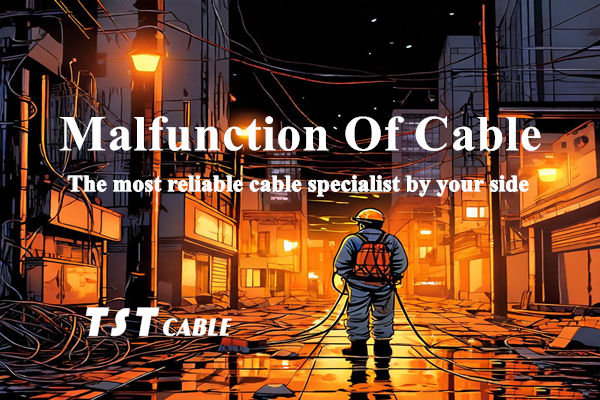
On the cable factory production line of TST CABLES, a cable customization manufacturer, there are dozens of cable test instruments with different functions. The cable fault tester is a professional device used to detect and locate faults in cable lines. Today, TST CABLES will take you to learn about the cable fault tester, hoping to be helpful to interested friends. Its design principle and composition usually include the following key parts:
Principle of cable fault tester
The working principle of the cable fault tester is mainly based on two basic methods: low-voltage pulse method and high-voltage flashover method.
Low-voltage pulse method:
By sending a low-voltage pulse signal to the cable, measuring the propagation time of the signal in the cable and the time difference of the reflection back, the length of the cable and the location of the fault point are determined. This method is suitable for detecting low-resistance, short circuit, open circuit and other types of faults.
High-voltage flashover method:
When there is a high-resistance or flashover fault in the cable, a high-voltage pulse is used to break through the fault point to generate a measurable flashover waveform. By capturing this random transient waveform and comparing it with the previously measured low-voltage pulse waveform, the fault point can be accurately located.
Cable fault tester composition
Cable fault tester usually consists of the following parts:
Cable fault tester host:
Contains a microprocessor control system for signal transmission, reception and digital processing.
Control signal type (such as low voltage pulse or high voltage flashover) and parameter setting.
Data acquisition, storage, digital filtering, distance calculation, waveform comparison, waveform ratio expansion and other functions.
LCD display screen, used to display test results and waveforms.
Cable fault tester signal generator:
Generates low voltage or high voltage pulse signals for testing.
High voltage generator:
Used to generate high voltage pulses to break down high resistance or flashover fault points in the cable.
Synchronous point finder:
Used to accurately locate the fault position near the cable fault point, usually working in conjunction with the host.
Cable path meter:
Used to detect the path and burial depth of the cable, and assist in fault location.
High voltage accessories:
Such as high voltage pulse capacitors, AC/DC dual-purpose high voltage test transformers and high voltage test transformer operation boxes, used for high voltage testing and safe operation.
Cable fault tester communication interface:
May include interfaces for communicating with a PC or other devices to facilitate data transmission and remote operation.
The cable fault tester can effectively detect cable faults through the coordinated work of these components, and help technicians quickly locate the fault point, and then take repair measures to restore the normal operation of the cable line.
Modern cable fault testers may also have some additional functions and technical features to enhance their performance and scope of application:
Advanced functions and technical features of cable fault testers
Automatic fault location system:
Some high-end cable fault testers have automatic fault location function, which can intelligently analyze signal waveforms, automatically calculate and display fault distances, and reduce the complexity and errors of manual waveform interpretation.
Multi-channel testing capability:
Allows multiple cable loops to be tested at the same time, improving work efficiency.
Data logging and analysis software:
Provides built-in or external data logging and analysis software to facilitate the storage of test data, historical comparison and trend analysis, and help predict possible problems in the future.
Wireless communication module:
Wireless connection with smartphones, tablets or computers via Bluetooth, Wi-Fi or mobile networks for remote monitoring and control.
Durability and environmental adaptability:
The equipment is usually designed to be resistant to high temperatures, waterproof, and dustproof, and can work stably in harsh environments, suitable for outdoor and industrial sites.
Safety features:
Built-in multiple safety protection mechanisms, such as overvoltage protection, overcurrent protection, short circuit protection, etc., ensure the safety of operators and equipment.
User interface and operation convenience:
The simple and intuitive user interface, touch screen or physical buttons, and clear operation guide make operation simpler and faster.
Battery power supply and energy-saving design:
The use of high-performance batteries has long-term working ability, and the energy-saving design is adopted to extend the use time after a single charge.
Compatibility and upgrade capability:
The equipment design takes into account compatibility with cables and accessories of different brands and models, and reserves software upgrade space to ensure function updates and performance optimization under long-term use.
These advanced functions and features of the cable fault tester have made it widely used not only in the power industry, but also in many fields such as telecommunications, construction, and transportation. Whether it is to maintain existing cable lines or to test cables before laying in new projects, cable fault testers are indispensable and important tools. With the advancement of technology, cable fault testers will become more intelligent and efficient in the future, bringing greater convenience and efficiency to cable maintenance. If you have any questions about cable fault testers or cable production, or want to obtain high-temperature cable samples, you are always welcome to contact TST CABLES engineers by email or phone.
Also available in:
English

